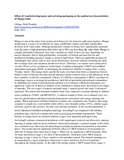| dc.description.abstract | Purple Passion (Passiflora edulis Sims) fruit is popular with Kenyan small holder farmers as a high returns enterprise, and with consumers for its characteristic aroma and flavor. However, it has a very short shelf life resulting in high postharvest losses. Passion fruit is a climacteric fruit that produces high levels of ethylene, the ripening hormone known to trigger deteriorative processes in harvested commodities. Postharvest losses in passion fruit are also attributed to rapid water loss leading to shriveling and consequent loss of aesthetic value and consumer appeal. Therefore, management of ethylene hormone and water loss through use of appropriate post harvest technologies is critical in maintaining quality and prolonging shelf life of passion fruits. This study was conducted to evaluate efficacy of two postharvest technologies in prolonging the shelf life of purple passion fruits while mantaining quality. The technologies evaluated were; I-Methylcylopropene (1-MCP), a competitive inhibitor of ethylene and activebagᆴ, a new product for modified atmosphere packaging (MAP) in the Kenyan market.
The fruits used in this study were harvested from a commercial orchard in Moiben district of Uasin Gishu County and analysis conducted at the Postharvest laboratory of lomo Kenyatta University of Agriculture and Technology. In the first experiment the efficacy of I-MCP, was evaluated on passion fruits harvested at two stages of maturity (stages I and 2) based on the peel color. Stage I fruits were mature green where the peel color was mostly green with traces of purple in the background while in stage 2 fruits the peel was 50-75% purple in color. For each maturity stage, two I-MCP treatment regimes based on concentration and time were administered namely: 2 ppm for 24 hours and 4 ppm for 12 hours. The third batch (for each maturity stage) was left untreated to act as the control. The fruits were then left to undergo normal ripening at ambient room conditions (25 ᄆ 1ᄚC and RH 60 ᄆ 5%). Six fruits from each treatment combination were randomly sampled for the determination of cumulative weight loss, rate of respiration and ethylene evolution every 2 days. Additionally, three fruits were randomly sampled every 3 days for the determination of other physicochemical parameters including peel/juice color, total soluble solids, sugars, total titratable acidity, ascorbic acid, beta carotene and mineral nutrients (calcium, iron, magnesium and potassium).
In the second experiment, the efficacy of activebagᆴ, was evaluated in comparison to the ordinary polythene bags which are commonly used to package fruits in the retail outlets. The fruits were harvested at two stages of maturity based on the peel color; stage 2 (50-70% purple) and stage 3 (full purple). The fruits were separately packaged using activebagᆴ, ordinary polyethene bags or left unpackaged (control) and then allowed to ripen under ambient room
conditions (25 ᄆ 1ᄚC and RH 60 ᄆ 5%). Six fruits from each treatment combination were randomly sampled at two day intervals for evaluation of the physiological and physicochemical changes associated with ripening and quality as described above. The results of the present study indicate that passion fruits harvested at both stages of maturity responded positively to I-MCP application with the shelf life being prolonged by 3 to 4 days relative to untreated control. Both I-MCP treatment regimes significkntly (P< 0.05) reduced the rate of ethylene evolution and respiration rate and delayed the occurrence of the ethylene peak and respiratory climacteric by 3 to 4 days. Most of the physicochemical changes associated with ripening were significantly delayed or reduced by I-MCP treatment in a trend mirrored to the respiratory activity. At the end of the storage period, I-MCP treated fruits retained relatively higher levels of quality-related attributes including sugars (fructose, glucose and sucrose) and ascorbic acid. Relatively higher levels of calcium and potassium were observed in I-MCP treated fruits (both regimes) throughout storage. Although fruits harvested at both stages responded positively to I-MCP application, stage 1 fruits failed to ripen and attain the desirable peel color, an effect that may negatively affect the consumer acceptance.
Modified atmosphere packaging significantly (P< 0.05) maintained post harvest quality of fruits harvested at both stages of maturity and prolonged their shelf life by 14 days and 6 days in case of activebagᆴ and ordinary polyethene bag respectively, compared to the unpackaged controls. The most significant effect of MAP was on slowing weight loss which was significantly lower compared to the unpackaged controls which were extensively shriveled by the end of storage. Additionally, both MAP packages reduced ethylene production and respiration rate and also slowed other physicochemical changes associated with passion fruit ripening. Although the ordinary polythene bag packaging prolonged the fruits' shelf life compared to unpackaged control, the positive effect was negated by high incidence of rotting evident <from the second week of storage. The results of this study indicate that commercial use of these two technologies (l-MCP and activebagᆴ) in passion fruits can be recommended for prolonging shelf life and marketing period hence minimizing post harvest losses. The use of I-MCP (both regimes) is recommended in passion fruits harvested-at stage 2. | en_US |

